Effect of Compressor-Discharge-Cooler Heat-Exchanger Length Using Condensate Water on the Performance of a Split-Type Air Conditioner Using R32 as Working Fluid
Abstract
:1. Introduction
2. System and Configuration
3. Experimental Facility and Method
- Measurement of A/C performance without a heat exchanger standard).
- Measurement of A/C performance using a heat exchanger with a length of 0.18 m.
- Measurement of A/C performance using a heat exchanger with a length of 0.20 m.
- Measurement of A/C performance using a heat exchanger with a length of 0.22 m.
4. Analysis of the Experimental Data
4.1. Effect on the Condenser Outlet Temperature
4.2. Effect on the Cooling Capacity
4.3. Effect on the Input Power
4.4. Effect on the Coefficient of Performance
4.5. Regression Analysis
5. Conclusions
- By applying HX as the subcooler, the degree of subcooling improved, with average improvements of 0.9, 1.5 and 4.5 K, at lengths of 18, 20 and 22 cm, respectively.
- The improvement in the degree of subcooling led to an increase in cooling capacity.
- Compared to the A/C without a subcooler, average increments in cooling capacity of 5.9, 8.9 and 14.9% and average net-input-power reductions of 2.4, 4.8 and 9.8% were achieved for the A/C with 18-, 20- and 22-centimeter-long HX, respectively.
- Compared to the method of evaporative cooling proposed by previous researchers, this method is superior in terms of its simplicity, its lack of requirement of additional input power and its ability to produce significant COP improvements of up to 27.3% (on average, for the longest HX, of 22 cm).
Author Contributions
Funding
Data Availability Statement
Acknowledgments
Conflicts of Interest
Abbreviations
| A | surface area of the evaporator, m2 |
| A/C | air conditioning |
| COP | coefficient of performance |
| average coefficient of performance | |
| specific enthalpy, kJ/kg | |
| HX | heat exchanger |
| I | electrical current, A |
| L | length of heat-exchanger pipe, m |
| η | isentropic efficiency, % |
| temperature difference, °C | |
| GWP | global-warming potential |
| ODP | ozone-depleting potential |
| refrigerant-mass-flow rate, kg/s | |
| ρ | air density, kg/m3 |
| P | refrigerant pressure, bar |
| PF | power factor |
References
- Llopis, R.; Nebot-Andrés, L.; Sánchez, D.; Catalán-Gil, J.; Cabello, R. Subcooling Methods for CO2 Refrigeration Cycles: A Review. Int. J. Refrig. 2018, 93, 85–107. [Google Scholar] [CrossRef]
- Pérez-Lombard, L.; Ortiz, J.; Pout, C. A Review on Buildings Energy Consumption Information. Energy Build. 2008, 40, 394–398. [Google Scholar] [CrossRef]
- Sukri, M.; Salim, M.A.; Mohd Rosli, M.A.; Azraai, S.; Dan, R.M. An Analytical Investigation of Overall Thermal Transfer Value on Commercial Building in Malaysia. Int. Rev. Mech. Eng. 2012, 6, 1050–1056. [Google Scholar]
- Qureshi, T.Q.; Tassou, S.A. Variable-Speed Capacity Control in Refrigeration Systems. Appl. Therm. Eng. 1996, 16, 103–113. [Google Scholar] [CrossRef]
- Kwon, L.; Hwang, Y.; Radermacher, R.; Kim, B. Field Performance Measurements of a VRF System with Sub-Cooler in Educational Offices for the Cooling Season. Energy Build. 2012, 49, 300–305. [Google Scholar] [CrossRef]
- Saidur, R.; Kazi, S.N.; Hossain, M.S.; Rahman, M.M.; Mohammed, H.A. A Review on the Performance of Nanoparticles Suspended with Refrigerants and Lubricating Oils in Refrigeration Systems. Renew. Sustain. Energy Rev. 2011, 15, 310–323. [Google Scholar] [CrossRef]
- Sabareesh, R.K.; Gobinath, N.; Sajith, V.; Das, S.; Sobhan, C.B. Application of TiO2 Nanoparticles as a Lubricant-Additive for Vapor Compression Refrigeration Systems—An Experimental Investigation. Int. J. Refrig. 2012, 35, 1989–1996. [Google Scholar] [CrossRef]
- Elbel, S.; Lawrence, N. Review of Recent Developments in Advanced Ejector Technology. Int. J. Refrig. 2016, 62, 1–18. [Google Scholar] [CrossRef]
- Bilir, N.; Ersoy, H.K. Performance Improvement of the Vapour Compression Refrigeration Cycle by a Two-Phase Constant Area Ejector. Int. J. Energy Res. 2009, 33, 469–480. [Google Scholar] [CrossRef]
- Arsana, M.E.; Kusuma, I.G.B.W.; Sucipta, M.; Suamir, I.N. Thermodynamic Analysis of Two-Phase Ejector as Expansion Device with Dual Evaporator Temperatures on Split Type Air Conditioning Systems. IOP Conf. Ser. Mater. Sci. Eng. 2019, 494, 12034. [Google Scholar] [CrossRef]
- Navarro-Esbrí, J.; Cabello, R.; Torrella, E. Experimental Evaluation of the Internal Heat Exchanger Influence on a Vapour Compression Plant Energy Efficiency Working with R22, R134a and R407C. Energy 2005, 30, 621–636. [Google Scholar] [CrossRef]
- Vijayan, R.; Srinivasan, P. Influence of Internal Heat Exchanger on Performance of Window AC Retrofitted with R407C. J. Sci. Ind. Res. 2009, 68, 153–156. [Google Scholar]
- Pottker, G.; Hrnjak, P. Experimental Investigation of the Effect of Condenser Subcooling in R134a and R1234yf Air-Conditioning Systems with and without Internal Heat Exchanger. Int. J. Refrig. 2015, 50, 104–113. [Google Scholar] [CrossRef]
- Pottker, G.; Hrnjak, P.S. Effect of Condenser Subcooling of the Performance of Vapor Compression Systems: Experimental and Numerical Investigation. In Proceedings of the International Refrigeration and Air Conditioning Conference, Purdue, IN, USA, 16–19 July 2012; p. 1328. [Google Scholar]
- Sumeru, K.; Sukri, M.F.; Falahuddin, M.A.; Setyawan, A. A Review on Sub-Cooling in Vapor Compression Refrigeration Cycle for Energy Saving. J. Teknol. 2019, 81, 155–170. [Google Scholar] [CrossRef] [Green Version]
- Klein, S.A.; Reindl, D.T.; Brownell, K. Refrigeration System Performance Using Liquid-Suction Heat Exchangers. Int. J. Refrig. 2000, 23, 588–596. [Google Scholar] [CrossRef]
- Rodríguez-Muñoz, J.L.; Pérez-García, V.; Belman-Flores, J.M.; Ituna-Yudonago, J.F.; Gallegos-Muñoz, A. Energy and Exergy Performance of the IHX Position in Ejector Expansion Refrigeration Systems. Int. J. Refrig. 2018, 93, 122–131. [Google Scholar] [CrossRef]
- Llopis, R.; Nebot-Andrés, L.; Cabello, R.; Sánchez, D.; Catalán-Gil, J. Experimental Evaluation of a CO2 Transcritical Refrigeration Plant with Dedicated Mechanical Subcooling. Int. J. Refrig. 2016, 69, 361–368. [Google Scholar] [CrossRef]
- Sumeru, K.; Sunardi, C.; Sukri, M.F. Effect of Compressor Discharge Cooling Using Condensate on Performance of Residential Air Conditioning System. AIP Conf. Proc. 2018, 2001, 020002. [Google Scholar] [CrossRef]
- Sumeru, K.; Margana, A.S.; Hidayat, S. Condensate Water as a Compressor Discharge Cooler to Generate Subcooling on the Residential Air Conditioning Using R32 as Refrigerant. J. Phys. Conf. Ser. 2019, 1295, 012044. [Google Scholar] [CrossRef]
- Lemmon, E.W.; Bell, I.H.; Huber, M.L.; McLinden, M.O. NIST Standard Reference Database 23: Reference Fluid Thermodynamic and Transport Properties-REFPROP, Version 10.0; National Institute of Standards and Technology: Gaithersburg, MD, USA, 2018.
- Delfani, S.; Esmaeelian, J.; Pasdarshahri, H.; Karami, M. Energy Saving Potential of an Indirect Evaporative Cooler as a Pre-Cooling Unit for Mechanical Cooling Systems in Iran. Energy Build. 2010, 42, 2169–2176. [Google Scholar] [CrossRef]
- Sawant, A.P.; Agrawal, N.; Nanda, P. Performance Assessment of an Evaporative Cooling-Assisted Window Air Conditioner. Int. J. Low-Carbon Technol. 2012, 7, 128–136. [Google Scholar] [CrossRef] [Green Version]
- Britto, J.J.J.; Vasanthanathan, A. Performance Evaluation of Window Air Conditioner by Incorporating Evaporative Cooling System on the Condenser. In Proceedings of the 2013 International Conference on Energy Efficient Technologies for Sustainability, Nagercoil, India, 10–12 April 2013; pp. 796–801. [Google Scholar]
- Sawan, R.; Ghali, K.; Al-Hindi, M. Use of Condensate Drain to Pre-Cool the Inlet Air to the Condensers: A Technique to Improve the Performance of Split Air-Conditioning Units. HVACR Res. 2012, 18, 417–431. [Google Scholar] [CrossRef]
- Tissot, J.; Boulet, P.; Trinquet, F.; Fournaison, L.; Lejeune, M.; Liaudet, F. Improved Energy Performance of a Refrigerating Machine Using Water Spray Upstream of the Condenser. Int. J. Refrig. 2014, 38, 93–105. [Google Scholar] [CrossRef]
- Ibrahim, N.I.; Al-Farayedhi, A.A.; Gandhidasan, P. Experimental Investigation of a Vapor Compression System with Condenser Air Pre-Cooling by Condensate. Appl. Therm. Eng. 2017, 110, 1255–1263. [Google Scholar] [CrossRef]
- Zhou, G.; Zhang, Y. Performance of a Split-Type Air Conditioner Matched with Coiled Adiabatic Capillary Tubes Using HCFC22 and HC290. Appl. Energy 2010, 87, 1522–1528. [Google Scholar] [CrossRef]
- Xu, L.; Hrnjak, P.S. Potential of Controlling Subcooling in Residential Air Conditioning System. In Proceedings of the International Refrigeration and Air Conditioning Conference, West Lafayette, IN, USA, 14–17 July 2014; p. 1465. [Google Scholar]


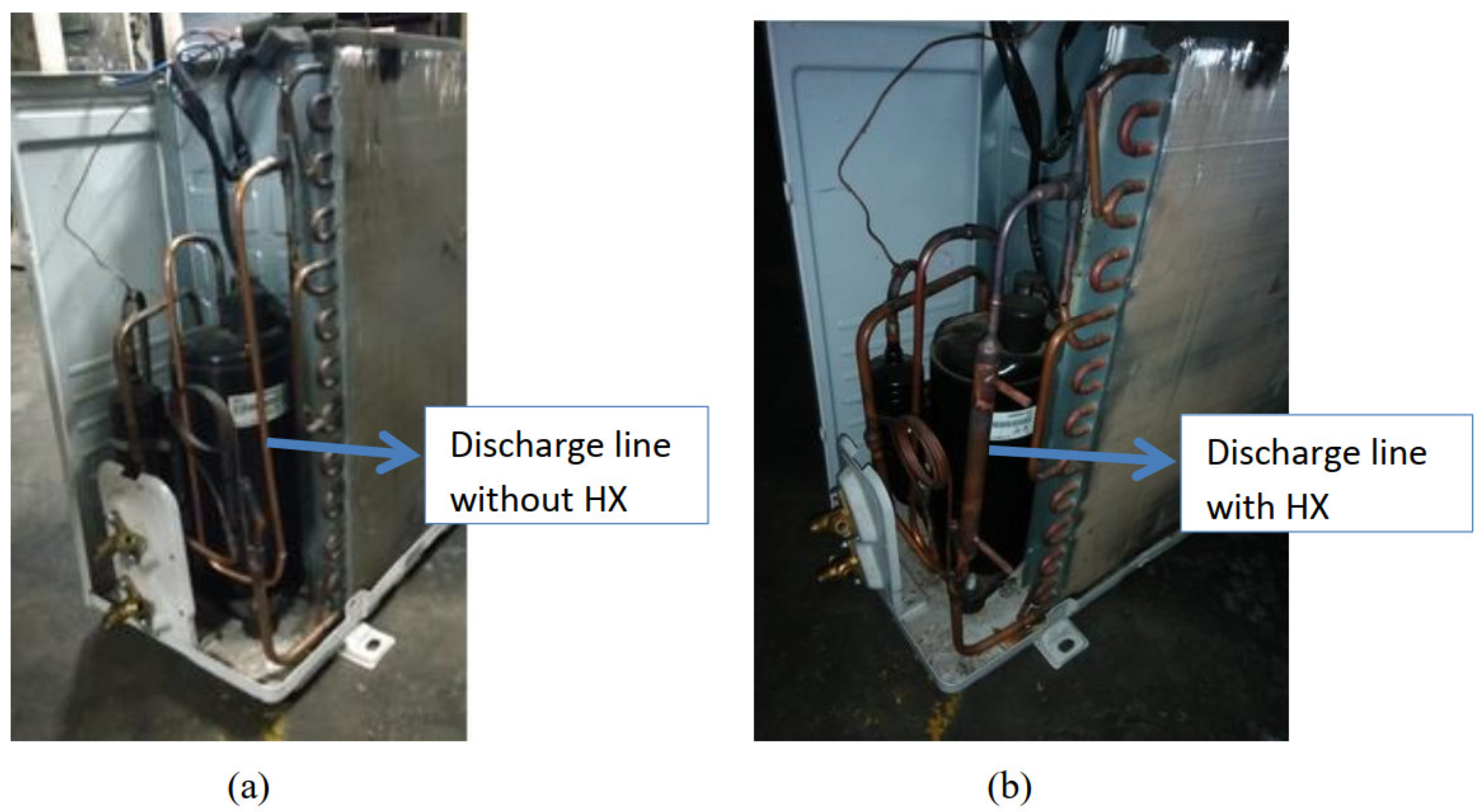

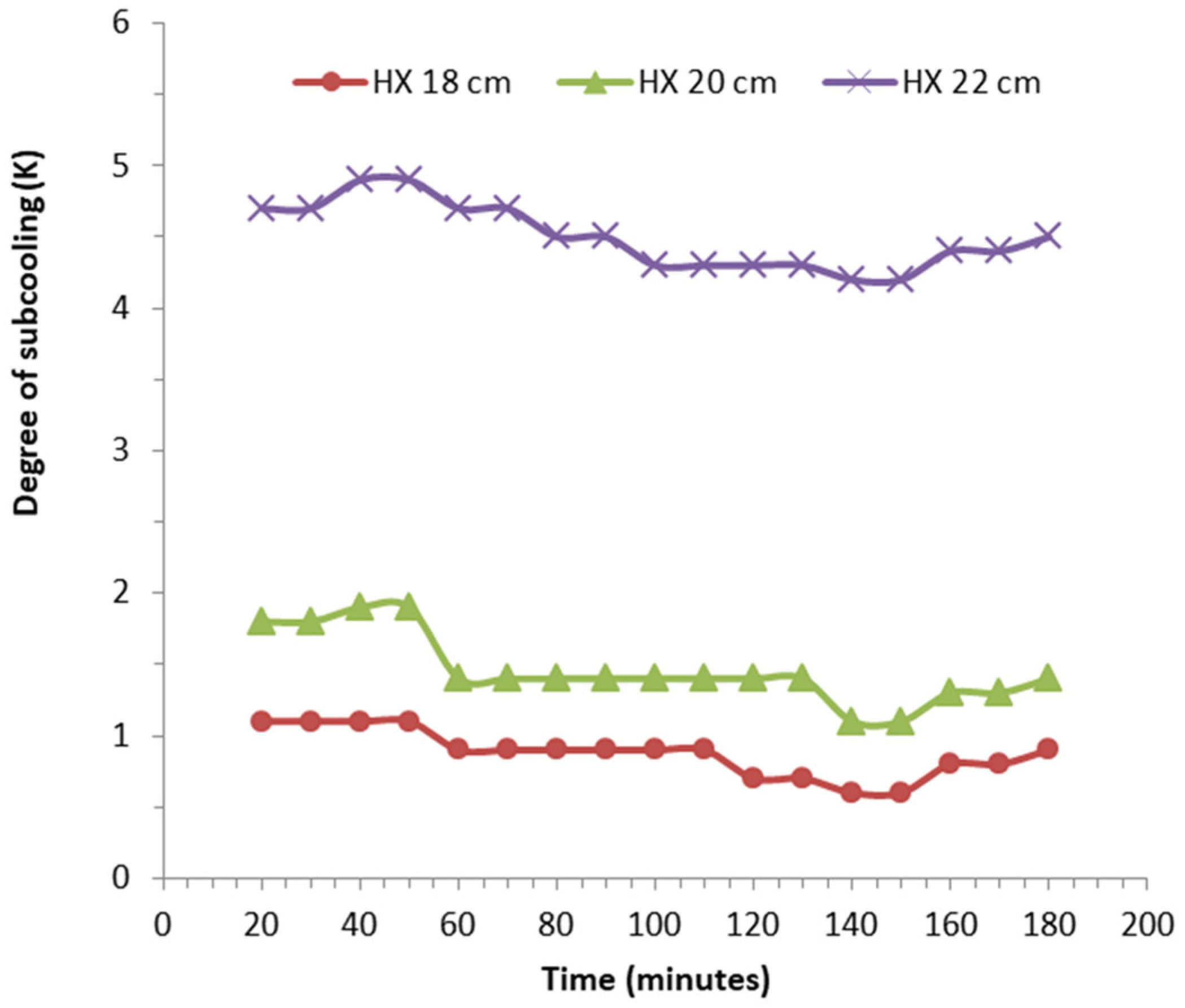
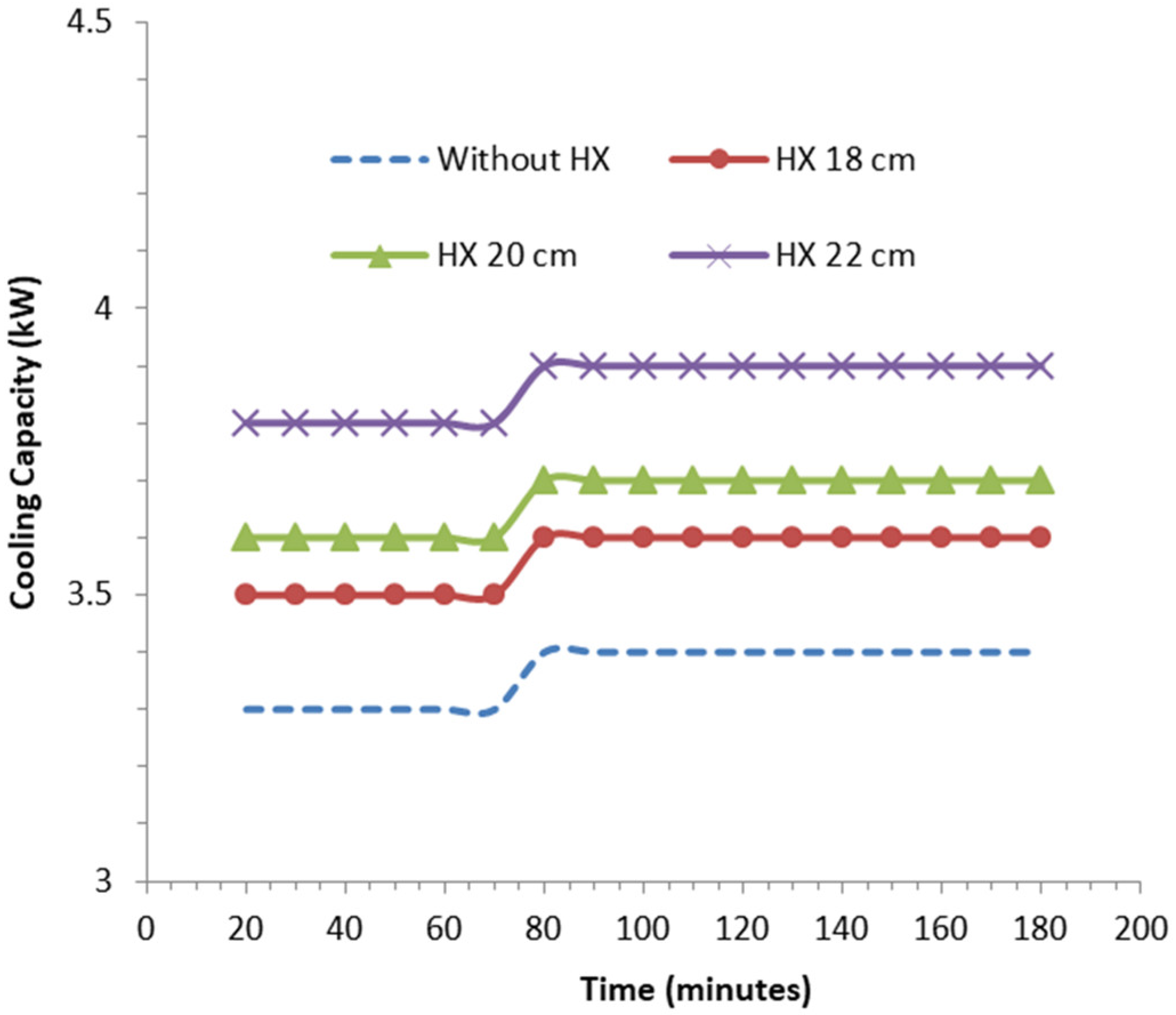

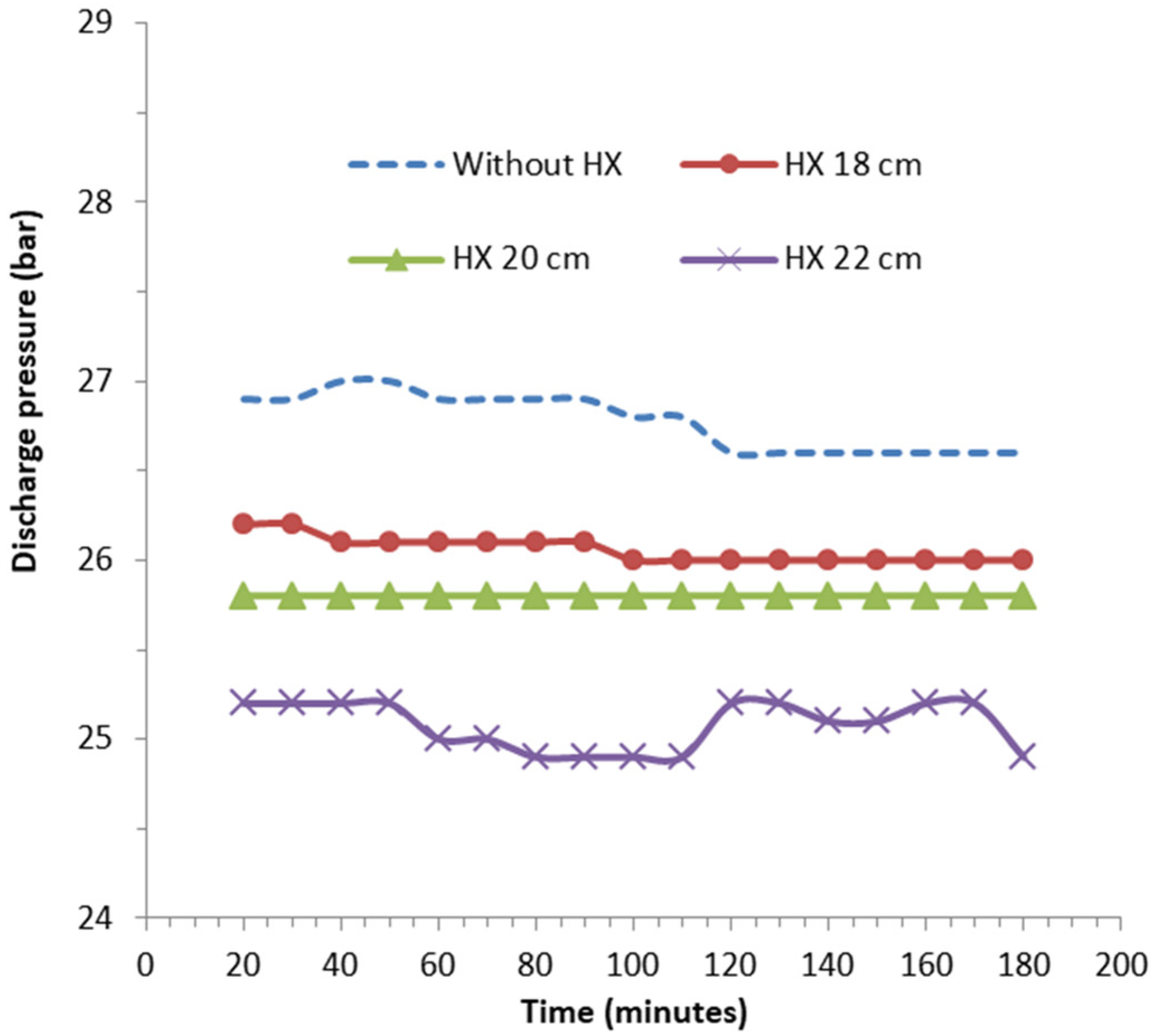
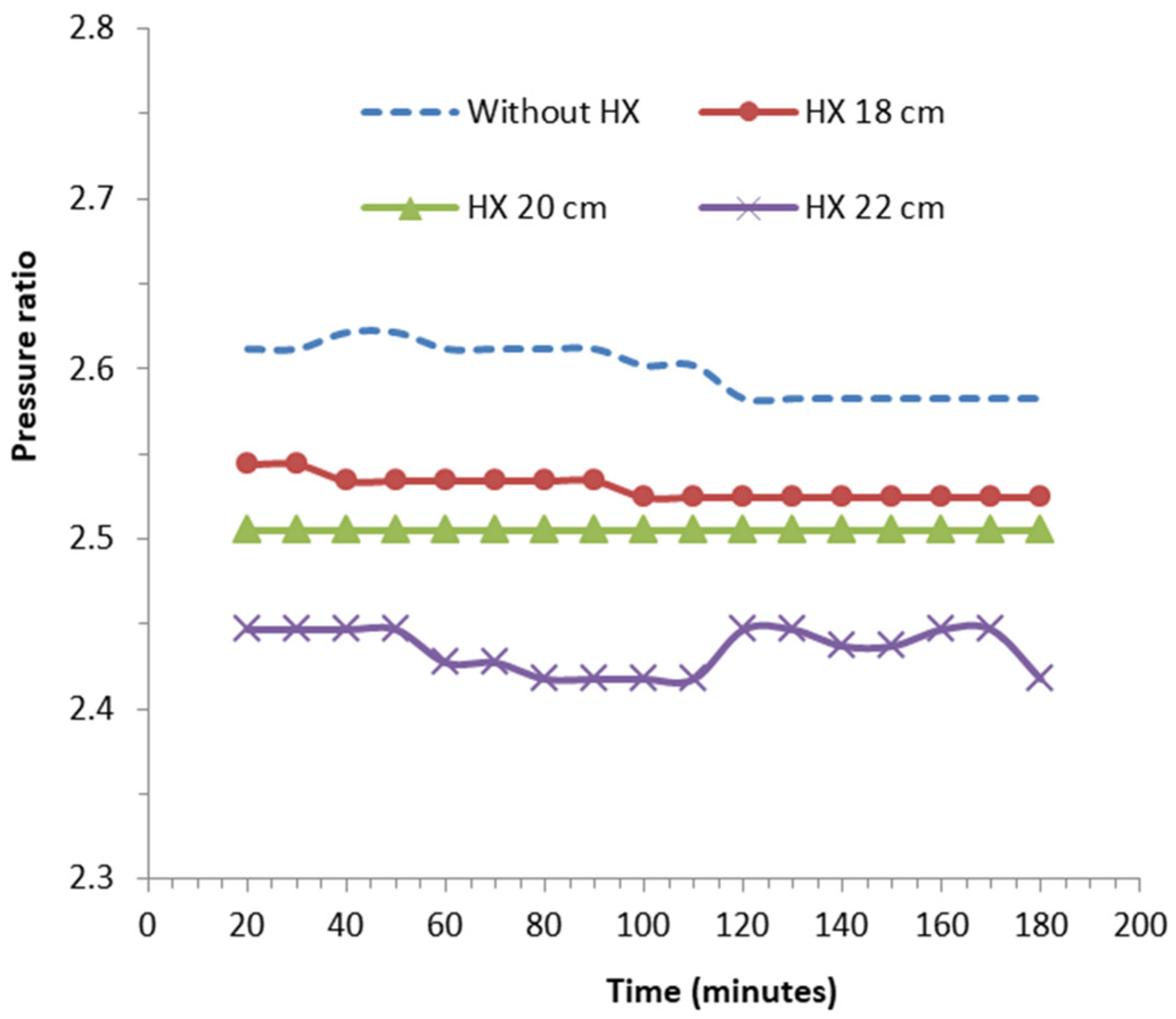
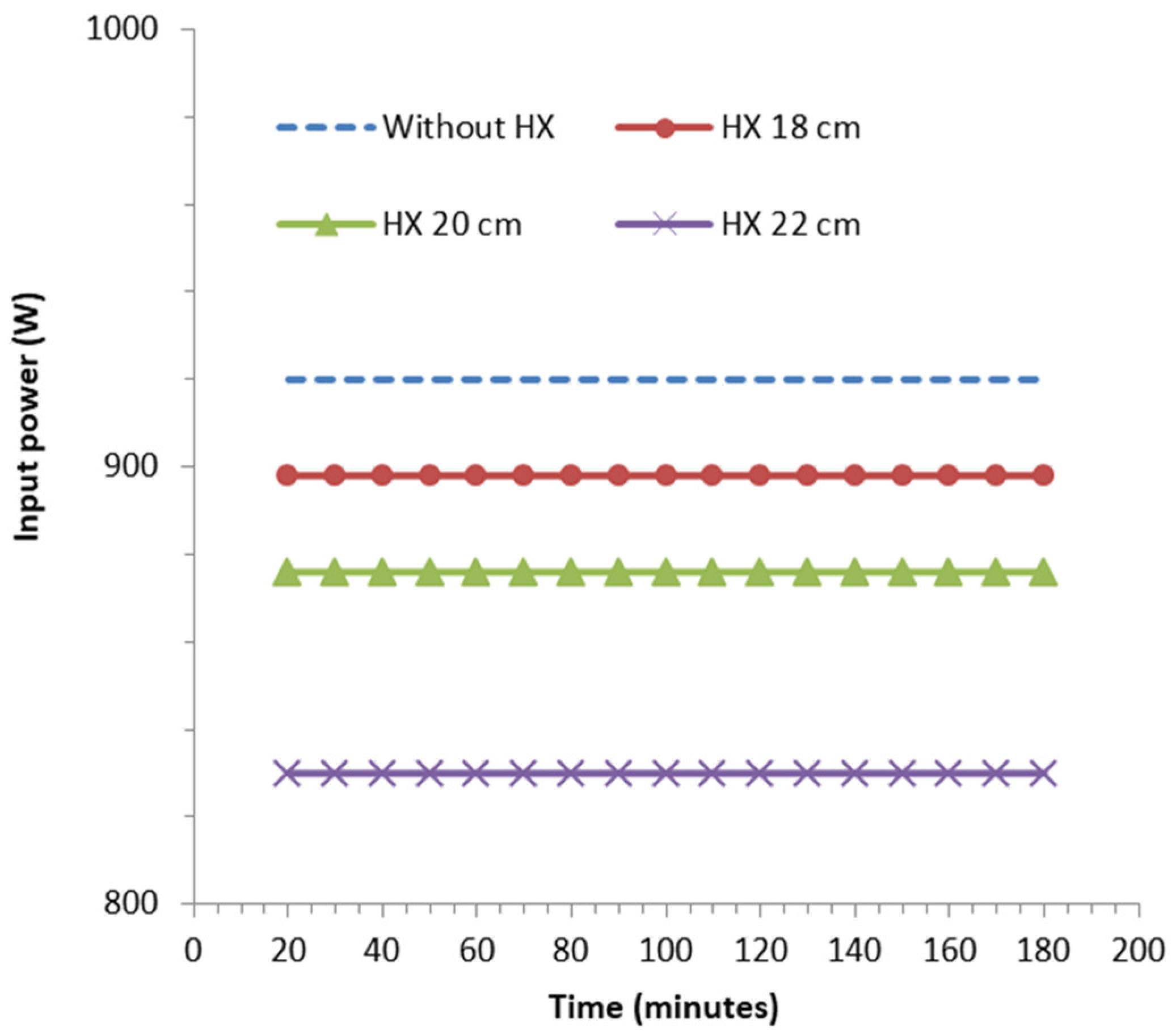
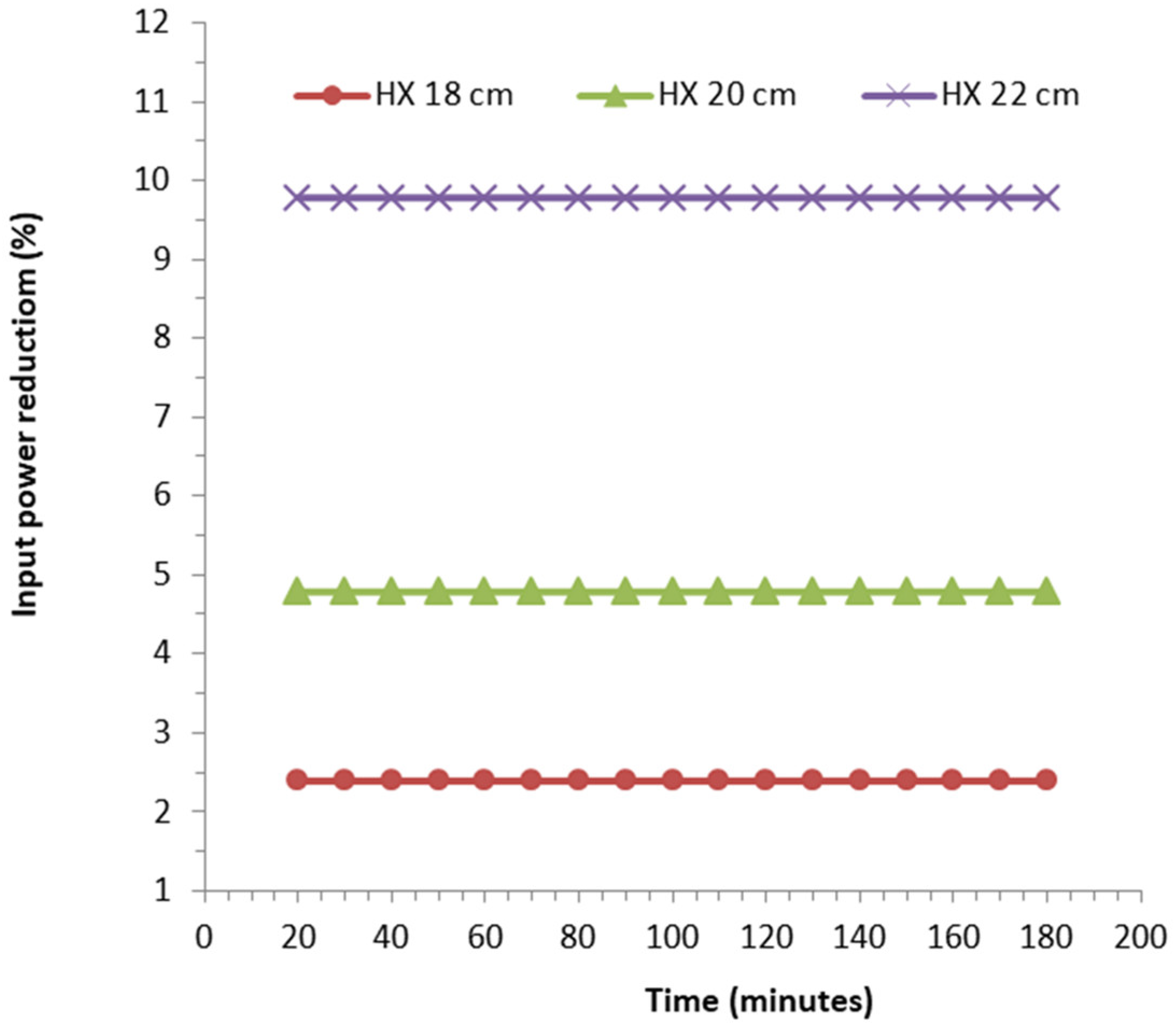
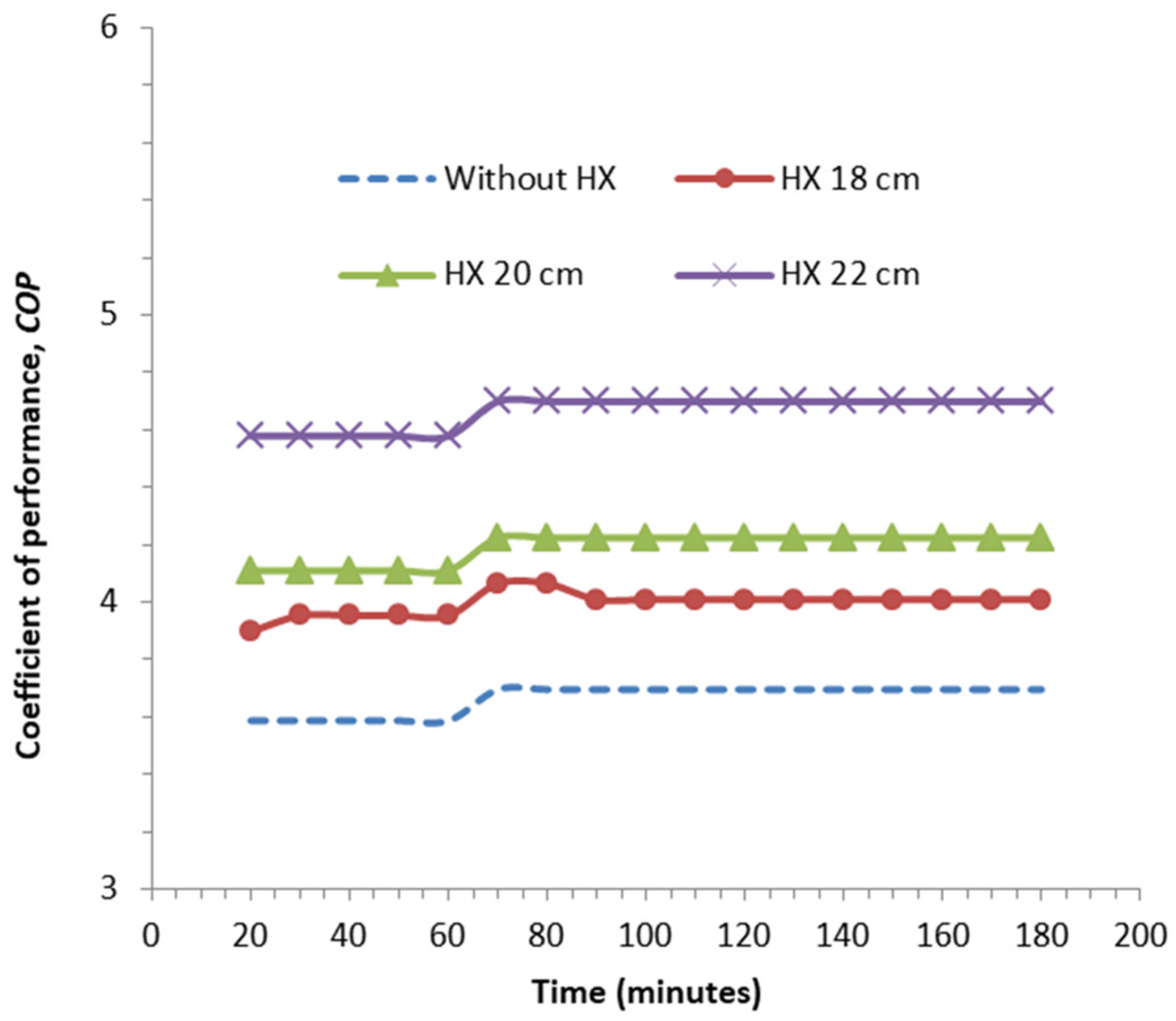
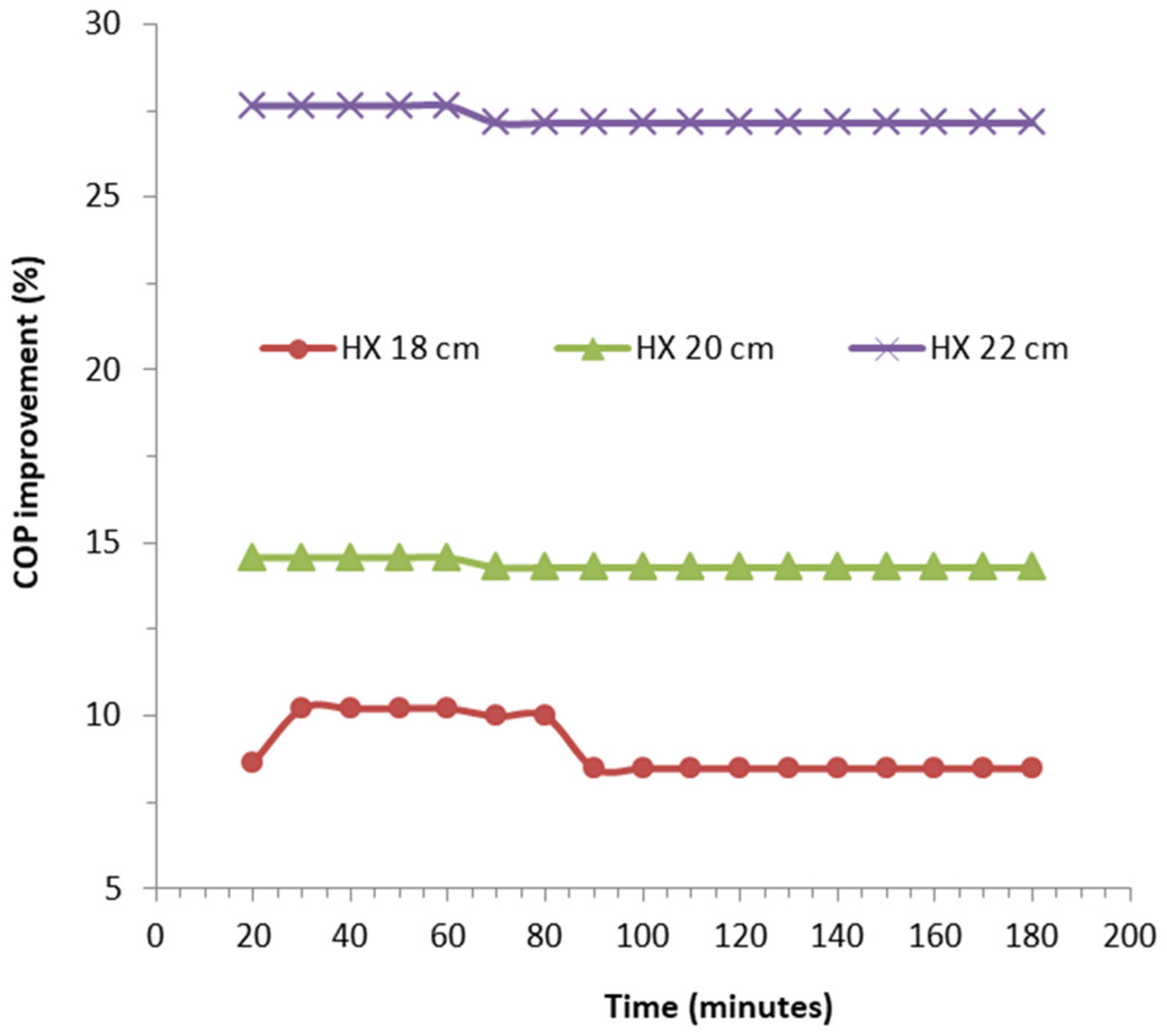
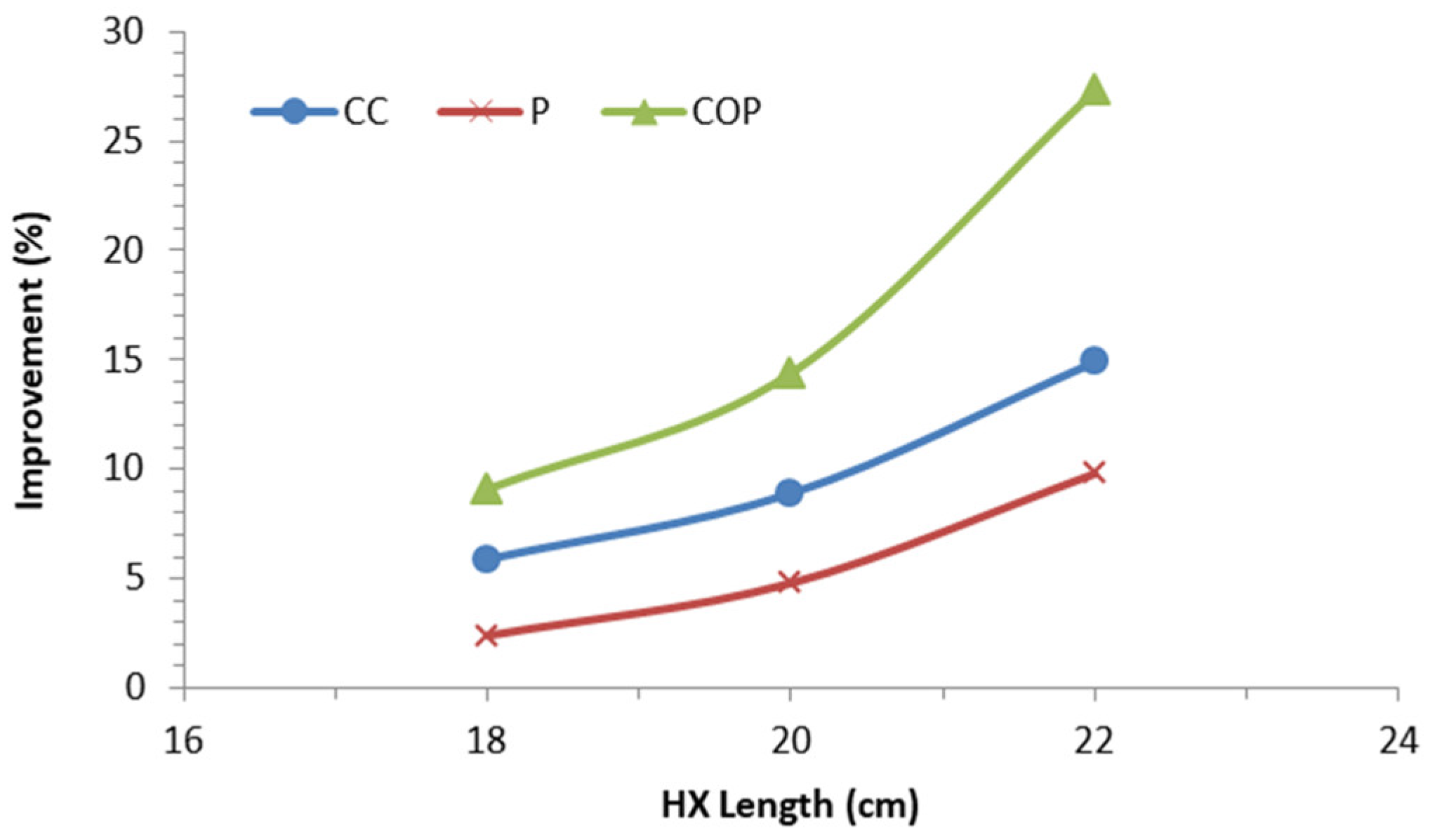
| Working Fluid | The Compressor Discharge Temperature (°C) | ||||
|---|---|---|---|---|---|
| = 0.50 | = 0.55 | = 0.60 | = 0.65 | = 0.70 | |
| R410A | 80.8 | 76.2 | 72.6 | 69.5 | 66.9 |
| R404A | 60.2 | 57.2 | 54.7 | 52.6 | 51.0 |
| R407C | 73.7 | 69.3 | 65.5 | 62.4 | 57.9 |
| R22 | 83.5 | 78.4 | 74.1 | 70.5 | 67.7 |
| R32 | 89.8 | 84.1 | 80.1 | 75.2 | 70.1 |
| Working Fluid | GWP | ODP |
|---|---|---|
| R410A | 2088 | 0 |
| R404A | 3300 | 0 |
| R22 | 1810 | 0.055 |
| R32 | 675 | 0 |
| No | Equipment | Measurements | Accuracy | Range |
|---|---|---|---|---|
| 1. | K-type thermocouple | Temperature | ±0.1 °C | −50 to 1300 °C |
| 2. | Pressure gauge | High pressure | ±0.5 bar | −1 to 38 bar |
| 3. | Pressure gauge | Low pressure | ±0.1 bar | −1 to 55 bar |
| 4. | Pitot-tube anemometer | Air velocity | ±0.05 m/s | −15 to 15 in H2O |
| 5. | Clamp-on-ammeter | Electrical current | ±0.1 A | 0 to 600 V |
| 6. | Voltmeter | Electrical potential | ±1 V | 0 to 400 A |
Publisher’s Note: MDPI stays neutral with regard to jurisdictional claims in published maps and institutional affiliations. |
© 2022 by the authors. Licensee MDPI, Basel, Switzerland. This article is an open access article distributed under the terms and conditions of the Creative Commons Attribution (CC BY) license (https://creativecommons.org/licenses/by/4.0/).
Share and Cite
Sumeru, K.; Pramudantoro, T.P.; Setyawan, A.; Muliawan, R.; Tohir, T.; bin Sukri, M.F. Effect of Compressor-Discharge-Cooler Heat-Exchanger Length Using Condensate Water on the Performance of a Split-Type Air Conditioner Using R32 as Working Fluid. Energies 2022, 15, 8024. https://doi.org/10.3390/en15218024
Sumeru K, Pramudantoro TP, Setyawan A, Muliawan R, Tohir T, bin Sukri MF. Effect of Compressor-Discharge-Cooler Heat-Exchanger Length Using Condensate Water on the Performance of a Split-Type Air Conditioner Using R32 as Working Fluid. Energies. 2022; 15(21):8024. https://doi.org/10.3390/en15218024
Chicago/Turabian StyleSumeru, Kasni, Triaji Pangripto Pramudantoro, Andriyanto Setyawan, Rizki Muliawan, Toto Tohir, and Mohamad Firdaus bin Sukri. 2022. "Effect of Compressor-Discharge-Cooler Heat-Exchanger Length Using Condensate Water on the Performance of a Split-Type Air Conditioner Using R32 as Working Fluid" Energies 15, no. 21: 8024. https://doi.org/10.3390/en15218024
APA StyleSumeru, K., Pramudantoro, T. P., Setyawan, A., Muliawan, R., Tohir, T., & bin Sukri, M. F. (2022). Effect of Compressor-Discharge-Cooler Heat-Exchanger Length Using Condensate Water on the Performance of a Split-Type Air Conditioner Using R32 as Working Fluid. Energies, 15(21), 8024. https://doi.org/10.3390/en15218024






